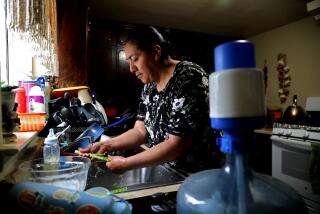Hospitals look for ways to cut water use during California drought
Hospitals are among the highest water users in communities, but have a lot of potential to help California fight its ongoing drought, according to the U.S. Environmental Protection Agency.
Jonah Schein, a technical coordinator for the EPA’s WaterSense Program, said the drought is shifting the focus of utilities’ efficiency from energy to water.
“Water efficiency in a lot of facilities has really been ignored. When you go in and do [water usage] audits, you often find that there is a lot of low-hanging fruit,” Schein said.
That is turning out to be the case at Oceanside’s Tri-City Medical Center in northern San Diego County, which has recently joined the growing ranks of California hospitals that are scrutinizing how they use every drop.
Chris Miechowski, Tri-City’s director of facilities, was looking for ways to save on the hospital’s utility bills in general when an audit prompted him to focus on cutting water use.
He brought in Long Beach-based Water Saver Solutions to help him find ways to cut back.
William Cordray, the company’s general manager, said his team has performed about 50 water audits at Southern California hospitals over the last five years.
Sometimes, he said, he can hear water being wasted before he can see it.
During a recent walk-through inspection of Tri-City, Cordray’s ears led him to six sterilizers, each emitting a faint rushing sound, like a running toilet.
Older sterilizers, he said, usually are kept running around the clock so surgical instruments can be steam-cleaned as soon as they’re needed.
But that causes hot water vapor to condense inside the devices, and the resulting water must occasionally be purged. Dumping it directly into the sewer would damage the pipes, so sterilizers are designed to keep a continuous flow of cold water, a gallon or more per minute, through the pipes to offset the occasional scalding water.
New retrofit kits include special holding tanks that let hot water cool before being discharged into the sewer, allowing hospitals to shut off the wasteful trickle of cold water.
While newer sterilizers for years have had these features built in, Cordray said he still encounters plenty of decades-old models trickling away. They can be refurbished, he said.
Faucets are another big source of potential water savings.
For years, hospitals used aerators to restrict water flow when taps were opened. However, studies found that those aerators were a source of infection: Each time a faucet was used, the devices held back a small amount of water, creating a tiny reservoir where harmful bacteria could multiply. After a death at a New York hospital was linked to Legionnaires’ disease found in a hospital’s water supply, many facilities nationwide removed their aerators entirely, allowing faucets to gush at the maximum number of gallons per minute.
However, there is another type of flow restrictor called a laminar that includes an antimicrobial coating that if properly maintained can eliminate bacteria and allow safe flow reduction.
Though these devices have been allowed by California building codes since at least 2008, Cordray said many hospitals have not installed them.
Clark Reed, national program manager for the EPA’s Energy Star Commercial Buildings program, said other savings can be found by installing separate water chillers for radiation oncology and MRI equipment and changing the water chemistry and operating parameters of the massive cooling towers used at most hospitals.
Yet one of the biggest ways to save water is by simply repairing leaks that might go undetected for years in large facilities, he said.
“Leaks really should be the first area to target from a water-management perspective,” Reed said. “A lot of these opportunities are there if you only start looking for them.”
Government programs offer rebates for installing water-saving equipment, which help cut costs.
After Tri-City’s walk-through inspection, Water Savers came up with a plan that it estimates will save more than 10 million gallons annually.
The plan calls for installing laminar flow restrictors, retrofitting sterilizers, changing the cooling tower operation, upgrading shower heads and toilets and replacing refrigeration compressors.
When rebates and incentives are added to the projected savings in water use, Miechowski said, most of the improvement costs will be recouped in about a year.
“We’re going to be able to take care of it within our existing budget through the savings we’re going to see in utility costs,” he said.
Paul Sisson is a reporter for the San Diego Union-Tribune.
MORE ON THE DOUGHT:
Receding lakes reveal pieces of California’s past
Heat and drought devastate sockeye salmon fishing and spawning on Washington rivers
Trickle-down politics: Drought could force real change among city, state leaders
More to Read
Start your day right
Sign up for Essential California for news, features and recommendations from the L.A. Times and beyond in your inbox six days a week.
You may occasionally receive promotional content from the Los Angeles Times.






